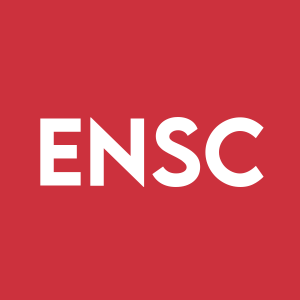Ensysce Biosciences to Present Groundbreaking Oral Overdose Protection for Opioids at the 5th Annual NIH HEAL Meeting
SAN DIEGO, CA / ACCESSWIRE / January 25, 2024 / Ensysce Biosciences, Inc. ("Ensysce" or the "Company") (NASDAQ:ENSC), a clinical-stage biotech company applying transformative chemistry to improve prescription drug safety to reduce abuse and overdose, today announced that Geoff Birkett, Chief Commercial Officer of Ensysce, will present a poster entitled "PF614-MPAR: A Novel Trypsin Activated Abuse Protected (TAAP™) Extended-Release Oxycodone Prodrug with Overdose Protection" at the Annual National Institutes of Health (NIH) "Helping to End Addiction Long-term" (HEAL) Initiative Scientific Meeting being held on February 7 and 8, 2024, in Bethesda, MD.
PF614-MPAR, the lead product under Ensysce's oral overdose protection platform, MPAR® (Multi-Pill Abuse Resistance), was just granted Breakthrough Therapy Designation by the U.S. Food and Drug Administration (FDA) and has been supported by funding from the National Institute on Drug Abuse (NIDA). The endorsements by both agencies have aided the clinical development of the first opioid with both abuse deterrent properties and importantly, oral overdose protection. We believe that no opioid on the market has these dual properties. The trial being presented was undertaken to optimize the PF614-MPAR combination drug product and successfully met its overdose protection endpoints.
"Noting the latest CDC data on prescription overdoses citing that we lose two people every hour has my team laser focused on ensuring Ensysce's drug products can be effective in reducing these numbers," said Dr. Lynn Kirkpatrick, Chief Executive Officer of Ensysce Biosciences. "We are grateful for the support of the NIH HEAL Initiative program and NIDA, and the corresponding funding which has been instrumental in advancing our efforts into combatting abuse and protecting against oral opioid overdose. The FDA BTD will also greatly assist in accelerating the development of PF614-MPAR, potentially a first-in-class ‘Next Generation' opioid designed to treat severe pain with these essential protective properties."
Geoff Birkett, CCO, added, "The Ensysce team is pleased with the exceptional data we were able to generate for our MPAR® platform and our lead agent, PF614-MPAR. The US opioid crisis has not been impacted by a new approach to address abuse for over the last two decades. Ensysce intends to change that with what we believe are disruptive platforms, TAAP and MPAR. We also believe our safer medications will address the growing issue of patients' lack of access to analgesics to treat severe pain, a situation caused by the opioid crisis."

About Ensysce Biosciences
Ensysce Biosciences is a clinical-stage company using its proprietary technology platforms to develop safer prescription drugs. Leveraging its Trypsin-Activated Abuse Protection (TAAPTM) and Multi-Pill Abuse Resistance (MPAR®) platforms, the Company is developing unique, tamper-proof treatment options for pain that minimize the risk of both drug abuse and overdose. Ensysce's products are anticipated to provide safer options to treat patients suffering from severe pain and assist in preventing deaths caused by medication abuse. The platforms are covered by an extensive worldwide intellectual property portfolio for a wide array of prescription drug compositions. For more information, please visit www.ensysce.com.
About the NIH HEAL Program
The HEAL Initiative is an effort to improve prevention and treatment strategies for opioid misuse and addiction and to enhance pain management across NIH institutes. The HEAL annual meeting is designed to bring together researchers, federal officials, people with life experience, and other stakeholders to share research findings, explore trends and shared interests, and ultimately to identify opportunities to advance the goals of the initiative. The meeting will include panels, scientific symposia, discussion groups, networking, and poster sessions for in-person and virtual attendees.
Forward-Looking Statements
Statements contained in this press release that are not purely historical may be deemed to be forward-looking statements for the purposes of the safe harbor provisions under The Private Securities Litigation Reform Act of 1995 and other federal securities laws. Without limiting the foregoing, the use of words such as "may," "intends," "can," "might," "will," "expect," "plan," "possible," "believe" and other similar expressions are intended to identify forward-looking statements. The product candidates discussed are in clinic and not approved and there can be no assurance that the clinical programs will be successful in demonstrating safety and/or efficacy, that Ensysce will not encounter problems or delays in clinical development, or that any product candidate will ever receive regulatory approval or be successfully commercialized. All forward-looking statements are based on estimates and assumptions by Ensysce's management that, although Ensysce believes to be reasonable, are inherently uncertain. All forward-looking statements are subject to risks and uncertainties that may cause actual results to differ materially from those that Ensysce expected. In addition, Ensysce's business is subject to additional risks and uncertainties, including among others, the initiation and conduct of preclinical studies and clinical trials; the timing and availability of data from preclinical studies and clinical trials; expectations for regulatory submissions and approvals; potential safety concerns related to, or efficacy of, Ensysce's product candidates; the availability or commercial potential of product candidates; the ability of Ensysce to fund its continued operations, including its planned clinical trials; the dilutive effect of stock issuances from our fundraising; and Ensysce's and its partners' ability to perform under their license, collaboration and manufacturing arrangements. These statements are also subject to a number of material risks and uncertainties that are described in Ensysce's most recent quarterly report on Form 10-Q and current reports on Form 8-K, which are available, free of charge, at the SEC's website at www.sec.gov. Any forward-looking statement speaks only as of the date on which it was made. Ensysce undertakes no obligation to publicly update or revise any forward-looking statement, whether as a result of new information, future events or otherwise, except as required under applicable law.
Ensysce Biosciences Company Contact
Lynn Kirkpatrick, Ph.D.
Chief Executive Officer
(858) 263-4196
Ensysce Biosciences Investor Relations Contact:
MZ Group North America
Shannon Devine
203-741-8811
ENSC@mzgroup.us
SOURCE: Ensysce Biosciences, Inc.
View the original press release on accesswire.com







